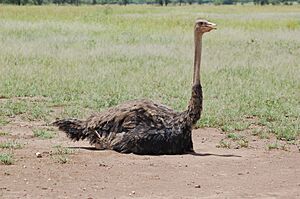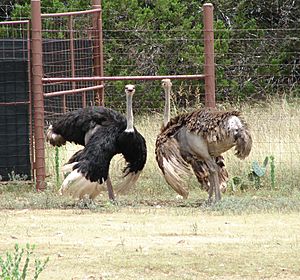Ostrich facts for kids
Quick facts for kids Ostrich |
|
|---|---|
 |
|
| Montage of the two living species: Common ostrich (left) and Somali ostrich (right) | |
| Conservation status | |
| Scientific classification |
|
| Kingdom: | Animalia |
| Phylum: | Chordata |
| Class: | Aves |
| Order: | Struthioniformes |
| Family: | Struthionidae |
| Genus: | Struthio Linnaeus, 1758 |
| Type species | |
| Struthio camelus Linnaeus, 1758
|
|
| Species | |
|
|
| Synonyms | |
|
|
Ostriches are amazing, large flightless birds. There are two main types alive today. These are the common ostrich from Sub-Saharan Africa. The other is the Somali ostrich from the Horn of Africa.
Ostriches are the heaviest and largest birds alive. An adult common ostrich can weigh from 63.5 to 145 kilograms. They lay the biggest eggs of any land animal. Ostriches are also super fast! They can run up to 70 km/h (43.5 mph). This makes them the fastest birds on land.
People raise ostriches all over the world. There are big ostrich farms in places like the Philippines and Namibia. South Africa makes about 70% of all ostrich products. The town of Oudtshoorn is a major center for this. Ostrich leather is valuable. Their big feathers are used as plumes for special hats. Humans have used Ostrich eggs and meat for thousands of years. Ostrich oil is also made from ostrich fat.
Ostriches belong to the group called Struthio. They are part of a larger family of flightless birds. This group is known as ratites. Other ratites include emus, rheas, cassowaries, and kiwis. Even giant extinct birds like elephant birds and moa were ratites. Long ago, the common ostrich also lived in the Arabian Peninsula. Ostriches were found across Asia, too. They lived as far east as China and Mongolia. This was during the Late Pleistocene and Holocene periods.
Contents
Amazing Ostriches: Giants of the Bird World
What Makes Ostriches Special?
Ostriches are truly unique birds. They cannot fly, but they are built for speed and strength. Their long, powerful legs help them run incredibly fast. They also have only two toes on each foot. This is different from most birds. This special foot design helps them run even faster.
Ostriches have long necks and small heads. Their eyes are the largest of any land animal. This helps them spot dangers from far away. They live in groups, which helps them stay safe. When they feel threatened, they can deliver a powerful kick.
Where Do Ostriches Live?
Today, you can find wild ostriches only in Africa. They live in dry, open areas. These include savannas and the Sahel region. They live both north and south of the central forest areas.
The Somali ostrich lives in the Horn of Africa. It developed separately from the common ostrich. A natural barrier, the East African Rift, kept them apart. In some places, the common ostrich and Somali ostrich live near each other. But they do not mix due to different behaviors.
Sadly, Arabian ostriches in Asia Minor and Arabia disappeared. They were hunted until none were left by the mid-1900s. In Israel, people tried to bring in North African ostriches. This was to replace the lost Arabian ostriches, but it did not work. Some common ostriches have escaped in Australia. They have formed wild populations there.
What Ostriches Eat
Ostriches mostly eat plants, but they also enjoy insects. Their plant diet includes seeds, shrubs, grass, fruits, and flowers. They also eat insects like locusts. Ostriches do not have teeth, so they cannot chew their food. Instead, they swallow small pebbles.
An adult ostrich carries about 1 kilogram (2.2 lb) of stones in its gizzard. This is a special part of their stomach. The pebbles help grind the food, making it easier to digest. Ostriches can go for several days without drinking water.
Ostrich Behavior
Social Life
During winter, ostriches often live alone or in pairs. But during breeding season, or when there's very little rain, they gather in nomadic groups. These groups can have five to 50 birds. They sometimes travel with other grazing animals, like zebras or antelopes.
Ostriches have excellent eyesight and hearing. This helps them spot predators like lions from far away. If a predator chases them, ostriches can run over 70 km/h (43 mph). They can keep a steady speed of 50 km/h (31 mph). This makes the ostrich the fastest two-legged animal in the world.
When they want to hide from predators, ostriches lie down. They flatten their heads and necks on the ground. From a distance, they look like a mound of earth. Males also hold their wings and tail low. The heat haze in their hot habitat helps them blend in.
Ostriches can handle many different temperatures. In their homes, temperatures can change by 40°C (72°F) between day and night. They control their body temperature using their wings. They can cover their bare legs and sides to stay warm. Or they can leave these areas uncovered to cool down.
Reproduction and Life Cycle

Ostriches are ready to have babies when they are 2 to 4 years old. Females mature about six months earlier than males. The way they mate can be different in various regions. Male ostriches will hiss and make other sounds to claim territory and mating rights. They try to attract a group of two to seven females, called a harem.
Males sometimes fight each other. These fights usually last only a few minutes. But they can be dangerous, as ostriches can hit opponents with their heads. The male who wins the fight gets to breed with all the females in that area. However, he will only form a strong pair bond with the main female.
The females lay their fertilized eggs in one large shared nest. This nest is a simple pit scraped in the ground by the male. It is usually 30 to 60 cm (12 to 24 in) deep and 3 m (10 ft) wide. The main female lays her eggs first. When it's time to cover the eggs for incubation, she removes extra eggs from the other females. Most nests end up with about 20 eggs.
Ostrich eggs are the largest of all eggs. The yolk inside is the largest single cell. Even though they are the largest eggs, they are actually small compared to the size of the adult bird. On average, an ostrich egg is 15 cm (6 in) long, 13 cm (5 in) wide, and weighs 1.4 kg (3.1 lb). This is more than 20 times the weight of a chicken egg!
The females sit on the eggs during the day to keep them warm. The males take over at night. This helps hide the nest. The drab female blends in with the sand during the day. The black male is almost invisible at night. The eggs hatch after 35 to 45 days.
Both male and female ostriches help raise the chicks. The male protects the young birds and teaches them how to find food. Not many chicks survive to adulthood, usually only one per nest.
Predators of Ostriches
When an ostrich feels threatened, it will either lie flat on the ground to hide or run away. If it gets trapped, it can kick very hard with its powerful legs. These kicks can cause serious injury or even death.
Common predators that attack ostrich nests and young chicks include jackals, various birds of prey, mongoose, and vultures. Animals that hunt ostriches of all ages include cheetahs, lions, leopards, African wild dogs, and spotted hyenas. Ostriches can often outrun their predators, even cheetahs, over long distances. However, they will sometimes fight fiercely against predators, especially when they are protecting their chicks. They have even been known to kill lions in such fights.
Ostriches and Humans
Ostriches are raised on farms in many countries. In the past, their feathers were very valuable. Today, they are farmed for their meat and eggs. Their skin can also be used to make leather.
In South Africa, hunters can collect one group of feathers from a wild ostrich. On farms, farmers can collect feathers every seven or eight months. The feathers will grow back, and they can be collected again.
Ostriches usually run away when threatened. But if they are cornered, they can kick forward with their powerful legs. These kicks can cause serious injury.
Ostriches that are raised by humans from a young age might try to court their human keepers instead of other ostriches. Ostriches typically live for 30 to 40 years.
It is a common myth that ostriches hide their heads in the ground when they are scared. This is not true.
Ostrich Racing

In some countries, people race each other on the backs of ostriches. This is more common in Africa and less so elsewhere. Ostriches are ridden much like horses, using special saddles, reins, and bits. However, they are much harder to control than horses.
The Ostrich Family Tree: Past and Present
How Ostriches Evolved
Ostriches belong to a bird group called Struthioniformes. These ancient birds first appeared about 56 million years ago. They lived across Europe, Asia, and North America. Scientists think the ostrich family started in Asia.
The oldest ostrich fossils are about 21 million years old. They were found in Namibia, Africa. This suggests that the Struthio group started in Africa. Later, they spread across Europe and Asia. In places like India, Mongolia, and China, ostriches lived until after the last ice age. Ancient drawings of ostriches have been found on pottery and rocks in China.
Different Kinds of Ostriches
Scientists classify ostriches into different species and subspecies. This helps us understand their family tree. The Somali ostrich (Struthio molybdophanes) is now recognized as its own species. This shows how scientists learn more over time.
Here are the main living species and some important extinct ones:
- Struthio molybdophanes, known as the Somali ostrich.
- Struthio camelus, known as the common ostrich.
- Struthio camelus camelus, the North African ostrich.
- Struthio camelus massaicus, the Masai ostrich.
- Struthio camelus australis, the South African ostrich.
- †Struthio camelus syriacus, the Arabian ostrich (now extinct).
- †Struthio asiaticus, the Asian ostrich (now extinct).
Images for kids
See also
 In Spanish: Struthio para niños
In Spanish: Struthio para niños









